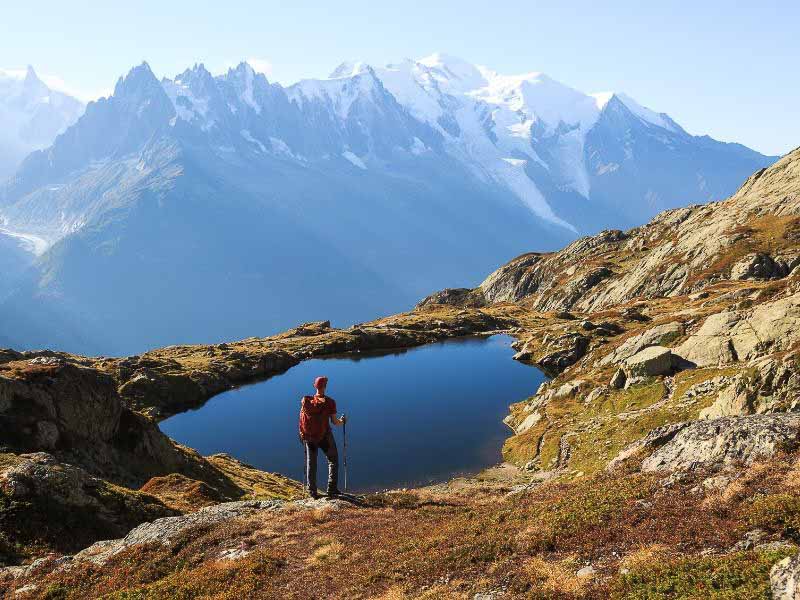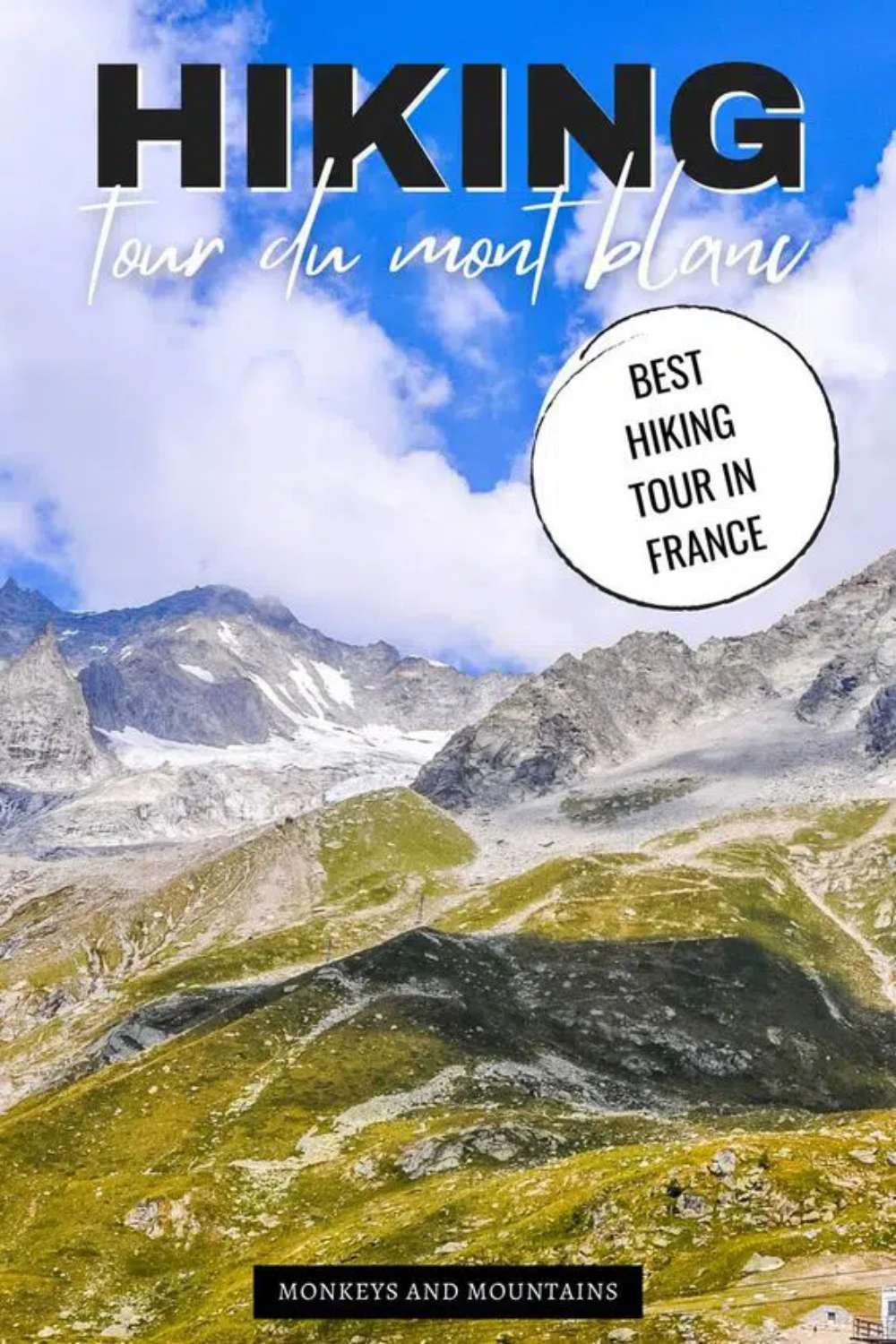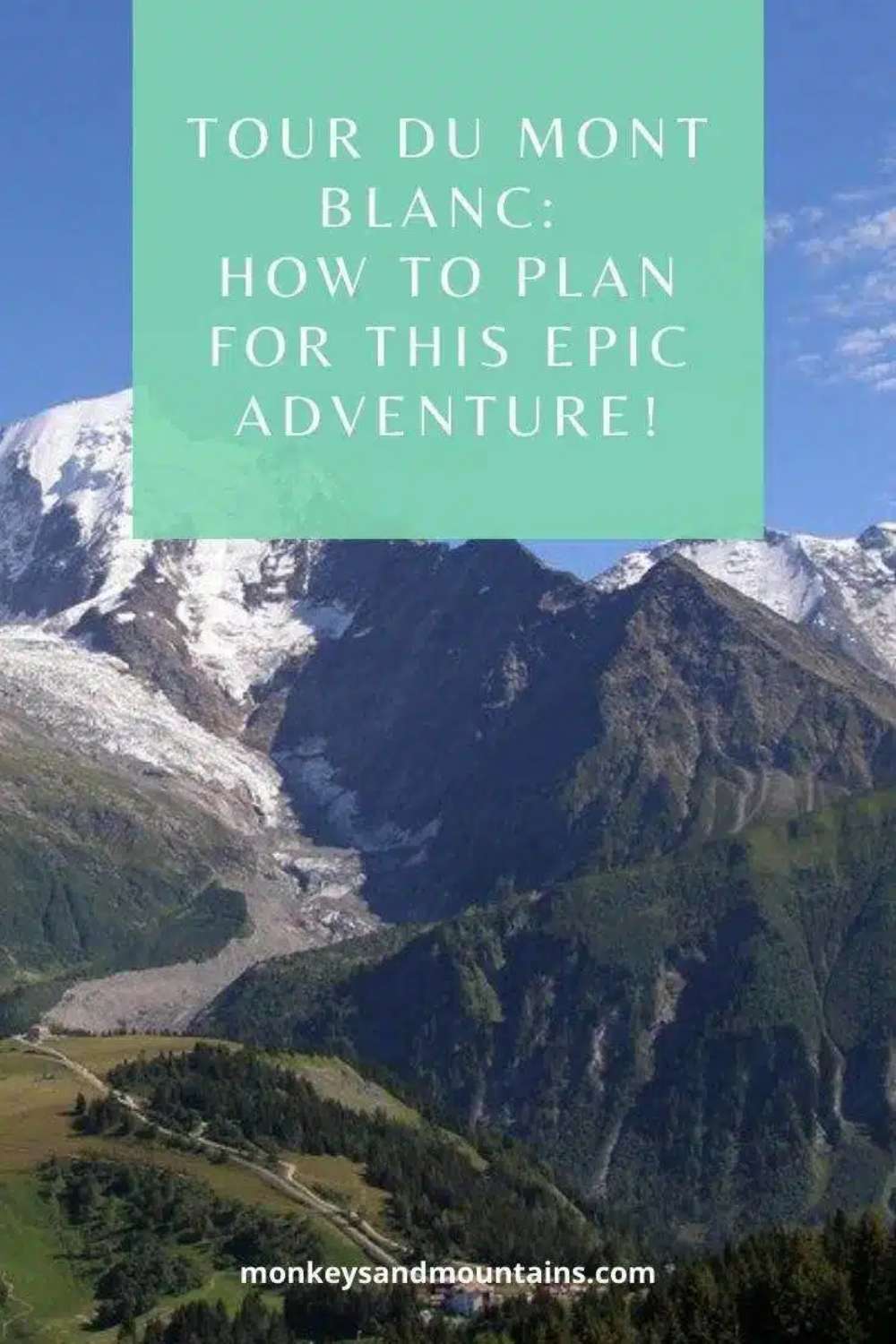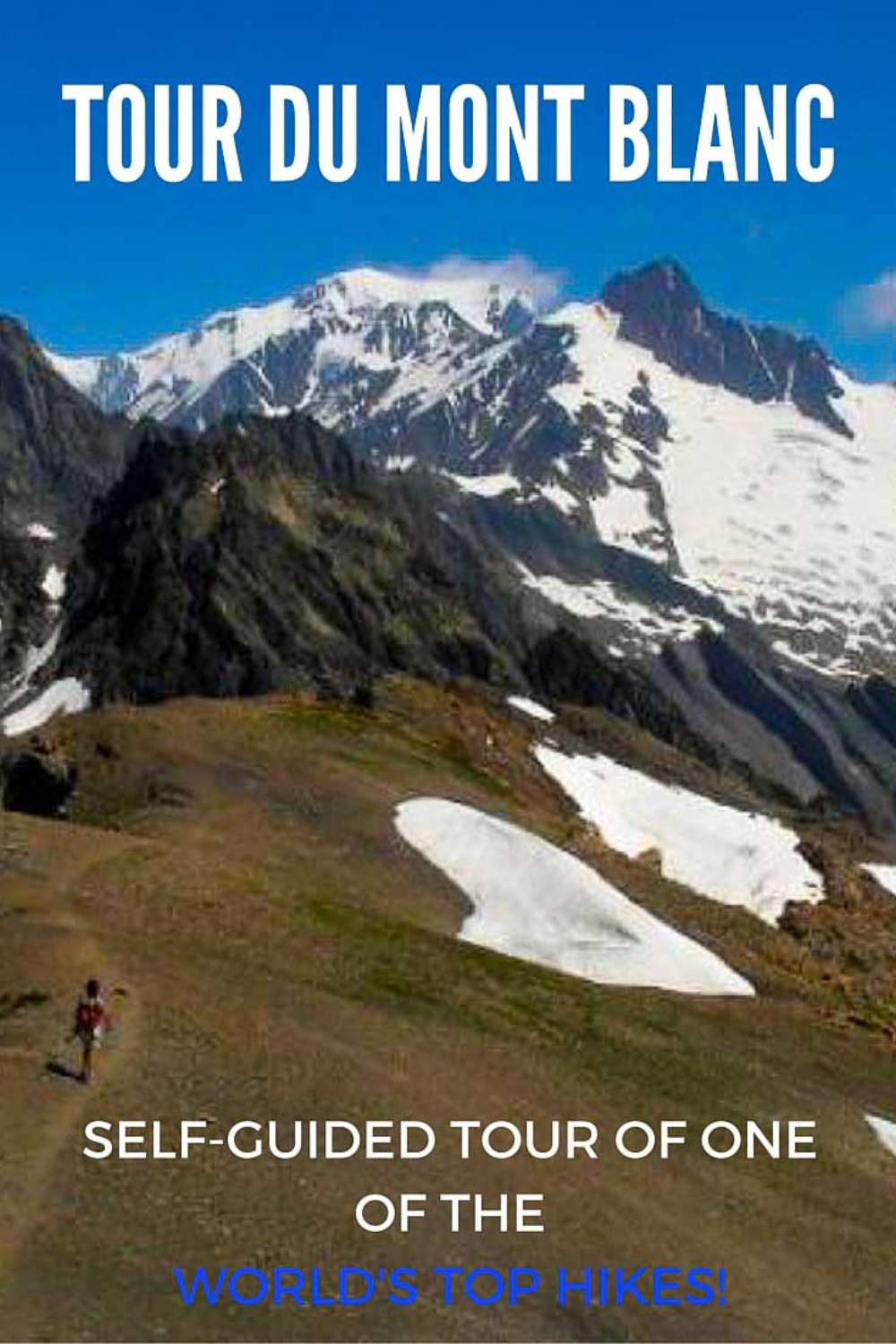Explore our complete Tour du Mont Blanc guide to find routes, itineraries, expert tips, and the details you need to plan your perfect TMB hike – start today!
The Tour du Mont Blanc hike is not only one of the most popular hikes in Europe, but one of the best long-distance hikes in the world! It’s at the top of many hikers’ bucket list and for good reason.
The classic hiking route takes you through the French, Italian and Swiss Alps.
It’s a beautiful multi-day hut-to-hut hike where you’ll have a warm bed and a hearty meal waiting for you every night.
I did the full Tour du Mont Blanc route before I started a hiking company. It was the first hike I’d done that was more than 3 days. Not long afterwards, I started a hiking company and have since repeated certain sections. Plus, I work with local partners in Chamonix to ensure that you get the most up to-date information.
Read on to find out how to plan your Tour du Mont Blanc hike.
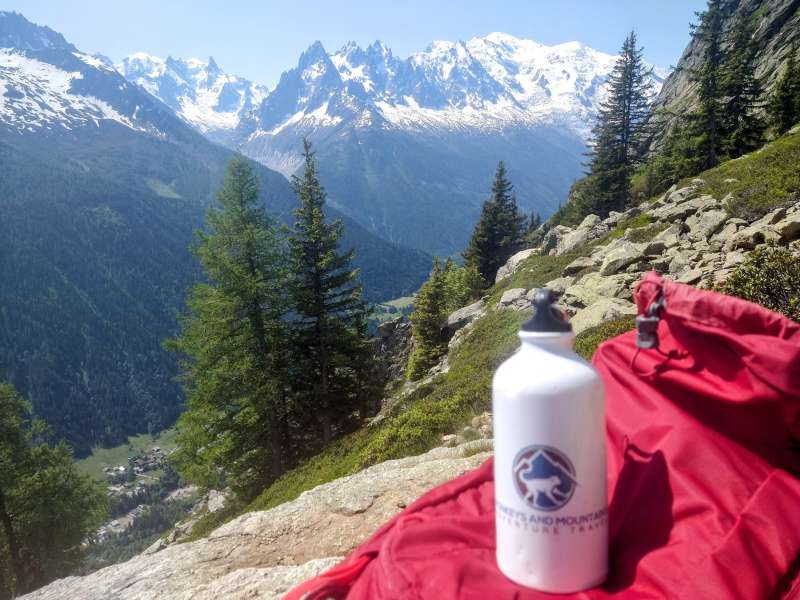
Highlights of the TMB
-
Col de Voza: Panoramic views of the Chamonix valley.
- Col de Tricot: Mountain pass offering stunning vistas, known for its challenging zigzag path.
-
Les Contamines: A charming French village that is a popular stopping point.
-
Col du Bonhomme: One of the first high mountain passes.
-
Croix du Bonhomme: Another mountain pass offering panoramic views.
- Col de la Seigne: A high mountain pass at 2,516 meters, marking the border between France and Italy, with panoramic views of the Mont Blanc Massif.
-
Rifugio Elisabetta: Mountain refuge in Italy, known for its stunning vistas.
-
Courmayeur: Italian alpine town perfect for a rest day, known for its cuisine and mountain culture.
-
Grand Col Ferret: The pass that crosses from the Italian Alps to the Swiss Alps offering some of the best views of the Grandes Jorasses.
-
Champex-Lac: Known as the “Swiss Lake,” a tranquil stopping point in Switzerland.
-
Bovine Route or Fenêtre d’Arpette: Two alternative routes between Champex and Col de la Forclaz; the former is easier, and the latter offers stunning views but is more challenging.
-
Col de la Forclaz: Another mountain pass and common place for rest.
-
Col de Balme: The pass back into France from Switzerland, with amazing views of Mont Blanc.
-
La Flégère and Lac Blanc: Offers one of the closest views of the Mont Blanc massif, which is sometimes reflected in Lac Blanc
What Is the Distance of the Tour du Mont Blanc?

As with all multi-day hiking trails in the Alps there is a “classic” route and then there are variations and shortcuts you can choose from. The main TMB route is:
-
Distance: 166 km (103 miles)
-
Total Elevation Gain: 10,000 m (32,700 ft)
-
Highest Point of the TMB: 2,665 meters (8,743 feet) at the Col des Fours and the Fenêtre d’Arpette
-
Number of Mountain Passes You’ll Hike Over: 10
-
Number of Days: 10 (although this can be shortened to 6 or 7 days)
- You can see a map of the tour here from Wikipedia.
Hiking the Tour du Mont Blanc: 3 Ways

Tour du Mont Blanc Guided
Tour du Mont Blanc Self Guided
Tour du Mont Blanc On Your Own
Below, I’ll outline the pros and cons of hiking the TMB in each of the three ways.
Tour du Mont Blanc Guided
| PROS | CONS |
| ✅ easiest and least time consuming option since you don’t need to plan logistics, your route, contact accommodations, etc. | X most expensive of the 3 options and the TMB route is well-marked so there’s minimal route finding required |
| ✅ you get insider knowledge from a local guide about the flora and fauna | X no flexibility, dates, route, room types etc are all pre-determined |
| ✅ great way to connect with other TMB hikers | X no choice of travel companions, you just. hope that you get along with everyone |
| ✅ luggage transfer is available to lighten your load |
We arrange guided tours with a French guide on request if you already have a small group. Contact us for details.
—————————————–
Tour du Mont Blanc Self Guided Trek
| PROS | CONS |
| ✅ saves you time in route planning | X more expensive than doing it yourself (but cheaper than a guided tour) |
| ✅ much cheaper than a guided tour of the TMB | X requires some route finding (but minimal as we provide you with the GPS tracks) |
| ✅ saves you time and frustration in booking accommodations, some of which are closed part of the year and are slow to get back to you | |
| ✅ gives you the flexibility to choose a start date that’s convenient for you | |
| ✅ you choose the tour length that’s best for you | |
| ✅ you choose your preferred room type (dormitory, private double, or luxury) | |
| ✅ you choose your hiking companions or to hike the TMB solo | |
| ✅ you choose when to start hiking each day and how long (or short) of a lunch break to take | |
| ✅ you can hike as slow or as fast as you want, without having to wait, or feel like you need to speed up for strangers | |
| ✅ you get GPS tracks, optional TMB variants like choosing to do the ladder sections or avoid them and shortcuts to make your route planning super easy | |
| ✅ you get an in-person briefing in Chamonix to find out the latest conditions on the TMB, insider tips and get any questions you have answered | |
| ✅ you can contact us while hiking the TMB in case of an emergency | |
| ✅ advise on logistics of getting to the start of the TMB, bus and lift schedules, etc. | |
| ✅ luggage transfer is available to lighten your load | |
| ✅ NEW! Get your own Personalized Fitness Plan Tailored Specifically for the TMB – valued at €300—FREE when you book with us. |
As you can see, the pros far outweigh the cons. That’s why I highly recommend a Tour du Mont Blanc Self-Guided Tour. We offer 6, 7 or 10 day tours, and can also customize one for you.
I do most of my own personal hiking trips as self-guided as well since I love the convenience, and time-saving of having someone else planning all the logistics so that I can just focus on hiking.
Find out more about the difference between guided and self-guided tours.
—————————————–
Planning the Tour du Mont Blanc On Your Own
| PROS | CONS |
| ✅ cheapest option | X time consuming to plan your TMB route |
| ✅ you can hike the TMB in as few or as many days as you like | X takes a lot of time to find accommodations, then book them since some of them are closed part of the year, and can be very slow to get back to you |
| ✅ gives you the flexibility to choose a start date that’s convenient for you | X you need to get the GPS tracks and ensure they’re accurate |
| ✅ you choose your preferred room type (camping, dormitory, private double, or luxury) | X you need to do the time-consuming research of the optional TMB variants, shortcuts, lift and bus schedules |
| ✅ flexible hiking each day – you choose when to start hiking each day, how many breaks to take and how slow or fast to hike | X you need to figure out the travel logistics and how to get to Chamonix logistics on your own |
| ✅ you choose your hiking companions or to hike the TMB solo | X you have no one to contact in case of an emergency while hiking the TMB |
Planning your own TMB hike is definitely the cheapest option, but also the most time-consuming and requires a lot of research.
If you choose the do-it-yourself option, I recommend that you plan it using a combination of this site: http://www.autourdumontblanc.com/en/, and the TMB: Complete Two-Way Trekking Guide Book by Cicerone Guides. And of course a good map and GPS tracks.
Our Tour du Mont Blanc Self-Guided Tours
Who’s the best company for a self-guided Tour du Mont Blanc hike?
Monkeys and Mountains Hiking Tours! We’re the only company that includes a free personalized hiking fitness program (worth €300) so you’ll train right—even if you live somewhere flat—and feel amazing on the trail. You’ll also get a private, in-person briefing to calm nerves, share the latest trail tips, and set off with total confidence.
As a small company working with trusted local partners, we actually remember your name and truly care about your trip. Just check out our Tour du Mont Blanc reviews—happy clients, repeat hikers, and even rewards when you refer friends.

Tour du Mont Blanc FAQs
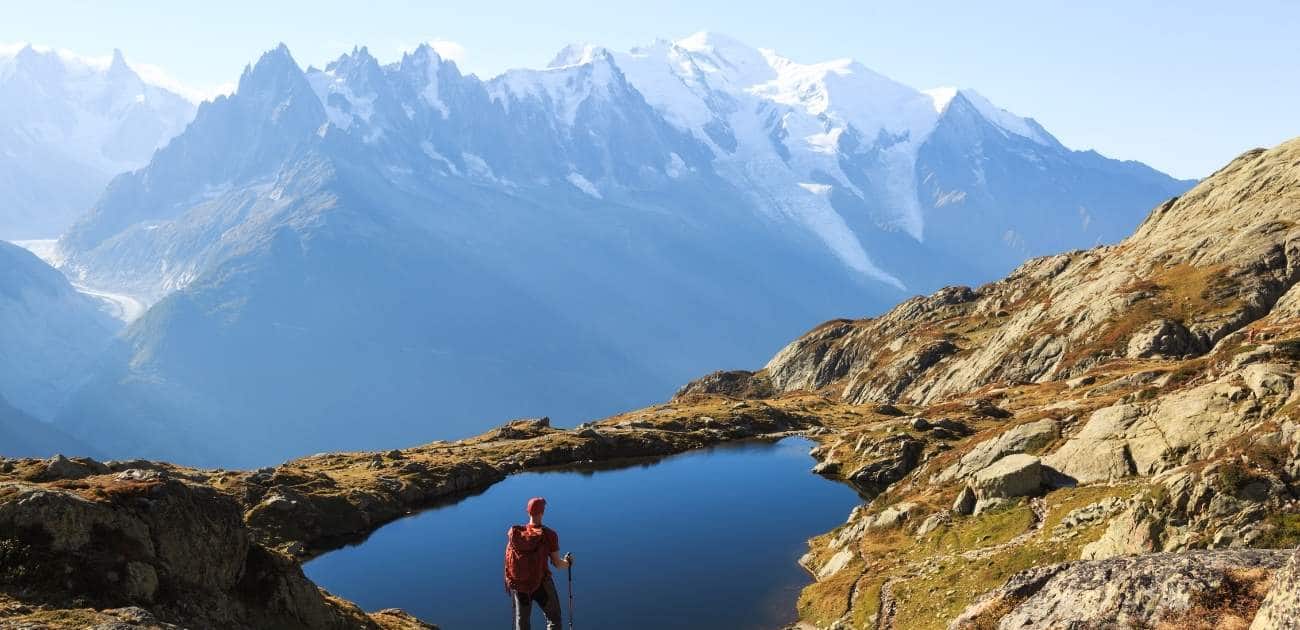
Who is the best company for a self-guided Tour du Mont Blanc hike?
• Monkeys and Mountains Hiking is the best company for a self guided Tour du Mont Blanc, hands down.
• We’re the only company that gives you a free personalized hiking fitness program (valued at €300), so you’ll know exactly how to train—even if you live in a flat area—and feel amazing on the trail.
• You’ll also get a private, in-person briefing to ease any last-minute nerves, share the latest trail conditions, and help you hit the trail with total confidence.
• As a small company that works with other trusted, like-minded local partners, we actually remember your name and genuinely care about making your adventure unforgettable.
• We have many happy clients, as you can see from our Tour du Mont Blanc reviews, plus plenty of repeat hikers—and we even reward our clients when they refer us to friends.
Where does the Tour du Mont Blanc Start & End?
Our 6 & 7 day tours start in the village of Les Houches. Our 10-day tour starts in Chamonix. All of our tours end in Chamonix.
What should I pack for the Tour du Mont Blanc?
See our packing list, which also includes my favourite small luxury item that I bring on every trek. You can also shop our packing list directly on Amazon.
Is the Tour du Mont Blanc Worth It?
Absolutely! I enjoyed most of it. I don’t believe anyone who says they enjoyed every second of the TMB. There are some tough parts!
Even better, it left me a lasting gift that is still giving. The gift of personal strength, both on and off the mountain. Little did I know that it would start an obsession with long-distance hiking. I now do at least one long-distance hike each year. Check out How a Hiking Trip Can Change Your Life.
Is the Tour du Mont Blanc crowded?
It’s getting busier every year and there are an estimated 20,000 hikers each year. The busiest times tend to be the first week in July and the last week in August when the TMB ultra are held. Having said that, while it’s a bit crowded at the start of each day with hikers leaving at around the same time, it starts to thin out pretty quickly as everyone hikes at a different pace. I recommend booking as early as possible so that you can start on your preferred date. Avoid doing it the last week in August as it’s very crowded then.
How technical/difficult is the Tour du Mont Blanc?
It’s not a technical hike, but it is physically demanding. You’ll be hiking on a mixture of paths and rugged terrain, but no technical skills are required. Having said that, avoid doing it in June or mid-September if you’re not comfortable hiking in snow.
To help with the physically demanding part, and new for 2025, we’re offering personalized fitness plans tailored for the Tour du Mont Blanc so that you’ll feel confident by the time you hit the trails.
How many miles/km is the Tour du Mont Blanc?
It’s 106 miles or 170km.
Is it possible to hike the Tour du Mont Blanc in June?
Yes, it’s possible from mid-June, but I think late June is a safer bet since the amount of snow varies each year. Having said that, some years the high passes aren’t possible at the end of June either due to too much snow. If you don’t want to hike in snow, then book mid-July-mid-August.
Is it safe to hike the Tour du Mont Blanc solo?
Yes. The Alps are generally considered safe. As a woman, I’ve also hike part of it alone and felt very safe. Plan to stay in dormitory accommodation since otherwise you’ll pay the price for a double room, as a solo hiker, which significantly increases the cost.
When’s the best time to hike the Tour du Mont Blanc?
It’s possible to do it from mid-June to mid-September but I think the best time is July and August because you’ll likely be able to do all the high passes – which isn’t always possible due to too much snow earlier in the season. Plus, all the transfers are running, which makes it cheaper than having to book private transfers if you’re doing the 6 or 7-day tour.
Is luggage transfer available on the TMB?
Yes, Monkeys and Mountains Hiking Tours offers luggage transfer as an option on all our TMB tours. If you book it yourself, you can contact a local company to arrange.
How to Get to Chamonix for the TMB?
The closest airport to Chamonix is GVA, in Geneva, Switzerland. This articles shares how to get from Geneva airport to Chamonix for your TMB adventure.
How to Train for the TMB?
Check out our How to Train for the TMB post with lots of tips. Plus, you can download your free 6-week training plan. When you book a TMB tour with us, you’ll get a free custom training plan designed for you. Valued at €300, but free when you book your TMB tour with Monkeys and Mountains Hiking Tours.
Do I need insurance for the TMB?
If you do one of our tours, yes, we require it. If you’re doing it by yourself, we still highly recommend it. You can find the right insurance for you with our handy Adventure Travel Insurance Finder. It will ask you a few questions, then provide personalized recommendations.
When is the TMB Ultramarathon?
There are a series of 7 races usually held from ~ Aug 22nd to 28th (depending on the year). Hikers should avoid going during this time as it’s very busy.
What are the best tips for doing the Tour du Mont Blanc?
I think the two big factors to consider are 1) What type of accommodations do you want? Luxury, private double or dormitory? and 2) How challenging do you want to make it? Then, design your trip around these factors as outlined in this article.
Will I get altitude sickness?
The highest point on the TMB is the Fenêtre d’Arpette (2,665 meters (8,743 feet). Anything below 3,000 meters is usually too low to cause altitude sickness for most hikers.
The TMB is not a high altitude trail so doesn’t pose the challenges that some other famous treks do.
Will I climb Mont Blanc?
No. Climbing Mont Blanc Massif involves mountaineering. Instead, you’ll hike around the 4809 m (15,771 foot) mountain. But don’t let that fool you, it’s still tough and not for beginner hikers.
Is it possible to camp on the TMB?
Yes – it is possible to camp or bivouac in villages along the Tour du Mont Blanc. However, there are strict regulations. Due to private land, protected reserves, and challenging terrain, only a few spots along the trail are suitable for bivouacking.
Campgrounds vary in facilities, with prices ranging from 10-25 EUR per night. However, some villages don’t have campgrounds, so you may need to detour a few kilometers extra to find a camping spot.
Ready to Book Your Tour Du Mont Blanc Hike?
Choose from one of our self-guided TMB tours below. Or contact us with any questions you have.
Now that you’ve explored our Tour du Mont Blanc guide, you’re equipped with routes, tips, and the details you need—time to start planning your TMB hike.

